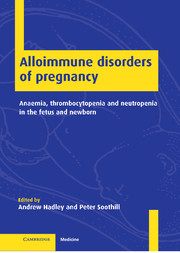 Alloimmune Disorders of Pregnancy
Alloimmune Disorders of Pregnancy Book contents
- Frontmatter
- Contents
- List of contributors
- Preface
- Foreword
- List of abbreviations
- 1 Pathophysiology of the alloimmune cytopenias
- 2 Blood group antibodies in haemolytic disease of the fetus and newborn
- 3 Basis and practice of screening for haemolytic disease of the fetus and newborn
- 4 Epidemiology and screening for alloimmune thrombocytopenia
- 5 Principles of antibody-mediated immune suppression and the prevention of maternal RhD alloimmunization
- 6 The clinical application of anti-D prophylaxis
- 7 Fetal genotyping
- 8 Laboratory assays to determine the severity of haemolytic disease of the fetus and newborn
- 9 Assessing the severity of haemolytic disease of the fetus and newborn: clinical aspects
- 10 Antenatal therapy for haemolytic disease of the fetus and newborn
- 11 Neonatal therapy for haemolytic disease of the newborn
- 12 The diagnosis of alloimmune thrombocytopenia
- 13 The immunological diagnosis of alloimmune neutropenia
- 14 Fetal and neonatal treatment of alloimmune thrombocytopenia
- Index
3 - Basis and practice of screening for haemolytic disease of the fetus and newborn
Published online by Cambridge University Press: 26 October 2009
- Frontmatter
- Contents
- List of contributors
- Preface
- Foreword
- List of abbreviations
- 1 Pathophysiology of the alloimmune cytopenias
- 2 Blood group antibodies in haemolytic disease of the fetus and newborn
- 3 Basis and practice of screening for haemolytic disease of the fetus and newborn
- 4 Epidemiology and screening for alloimmune thrombocytopenia
- 5 Principles of antibody-mediated immune suppression and the prevention of maternal RhD alloimmunization
- 6 The clinical application of anti-D prophylaxis
- 7 Fetal genotyping
- 8 Laboratory assays to determine the severity of haemolytic disease of the fetus and newborn
- 9 Assessing the severity of haemolytic disease of the fetus and newborn: clinical aspects
- 10 Antenatal therapy for haemolytic disease of the fetus and newborn
- 11 Neonatal therapy for haemolytic disease of the newborn
- 12 The diagnosis of alloimmune thrombocytopenia
- 13 The immunological diagnosis of alloimmune neutropenia
- 14 Fetal and neonatal treatment of alloimmune thrombocytopenia
- Index
Summary
Introduction
Levine and Stetson in 1939 first discovered an irregular agglutinating antibody in a previously transfused woman who had given birth to a stillborn child. However, it was not until IgG nonagglutinating (or ‘incomplete’) red cell antibodies could be demonstrated serologically that screening methods for HDFN began to be developed. These included the albumin method, the indirect antiglobulin test (IAGT) and the enzyme method. Of these, the albumin method is used less frequently, but the IAGT and, to some extent, the enzyme method remain important in serological screening for HDFN. This chapter reviews these methods and their ability to provide information that is useful for clinicians to identify and manage women at risk of HDFN.
The basis of screening for HDFN
Adequate and relevant information concerning the presence and nature of red cell alloantibodies in the plasma of pregnant women is essential for the effective management of potential HDFN. The purpose of screening in the laboratory is to provide this information to clinicians. Serological methods are effective in antenatal screening programmes because they are capable of detecting the vast majority of red cell alloantibodies that can cause HDFN (Section 2.5). Furthermore, methods can be chosen which detect IgG antibodies active at 37°C but which do not detect IgM antibodies active at temperatures below 37°C, since these antibodies do not cause HDFN. Serological methods are also used to determine the potency of antibodies (the strength of their reactivity with red cells) (Section 8.2).
- Type
- Chapter
- Information
- Alloimmune Disorders of PregnancyAnaemia, Thrombocytopenia and Neutropenia in the Fetus and Newborn, pp. 41 - 60Publisher: Cambridge University PressPrint publication year: 2001


